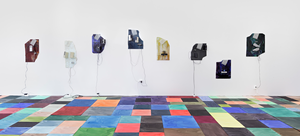FRIEZE FOCUS: Painting, poetry and measuring movement
What a mess. When I walked into Natalie Häusler’s solo show Case Mod
at Supportico Lopez, Berlin in January, I expected to find the work I’d
seen on the gallery’s website. The installation shots of monika/subway (floor piece)
(2012) promised a neat grid of cardboard tiles, painted in bright
acrylic colours and covering the gallery’s main floor. By the time I
arrived, the tiles were wildly scattered and marred by dusty footprints.
Häusler had fastidiously positioned them but failed to use glue. The
mingling of guests at the opening had displaced them over the course of
the evening. The most beaten footpath near the entrance bore the brunt
of the destruction while tiles near the walls were untrampled. As an
itinerary, monika/subway started as a grid of happy shades, only to end
up mapping visitor traffic. But it was disturbing to see in one fell
swoop this gradual accumulation of movement, which suggested a disaster
and its victims, say, or the path of a tornado and the stampede of
people escaping. Only then did it occur to me that a twister in
slow-motion might look like a ballet of objects. And that Häusler’s
installation might be about measuring movement, speed, duration – a kind
of action painting in an expanded field.
This field includes not only installations and painting but also poetry,
which – since she fuses all three – allows for the different actions of
exhibiting, writing, reading, recitation and listening. By 2011,
Häusler – who was born in Munich and moved to Berlin in 2012 after two
years in New York (the first on a DAAD grant) – had earned an MFA
from Bard College and a Meisterschüler degree from Braunschweig, both
in painting. The same year, she also co-founded the poetry press AMERICAN BOOKS
with poets Ed Steck and Brett Price. The first publication
Solicitations (2012) – with contributions from 35 artists and writers
– was published last July. The first of Häusler’s poems to appear in her
art – LOSS – LUST
I in her eponymous installation-performance staged at Bard in 2010 –
was printed on foolscap, read aloud by two friends and then scattered
across the installation, like salt on soup. The poem – partly in German,
mostly in English – cites a 1920 letter by Franz Kafka, persuading his
beloved Milena Jesenská that they can see each other better in writing
than through actually meeting. Häusler adds her takes on opacity and
knowledge in the relation between the artist, the work and its viewers:
‘to reveal your process makes you vulnerable’. As her friends read her
poem, Häusler spilled ink on the installation’s fabrics and booklets,
which recalled Rorschach tests and censorship; interpretation and
illegibility. Since then, her poems have appeared in other materials
beyond paper and measure other actions beyond recitation. For Ann (rising) (2012) – an installation for the display windows of Motto bookstore in Berlin – included fragments of her poem BED (2012) printed on champagne glasses, themselves broken into shards. Other installations like A situation of subtle control/ inward-outward gaze (2011) and We are getting a little bit too close here (still life)
(2012) – shown last year at Kunsthalle Ravensburg for the +6|2012
Shortlist Columbus Art Award – feature poems printed on table-like
surfaces. Yet the words look distorted, as if they were floating in
water or reflected in a funhouse mirror. Häusler likes such effects of
movement, perhaps as a textual take on drip painting, and light palettes
that combine colours while keeping them distinct: tiles, screensavers,
watercolours, stained glass. Case Mod featured eight broken
pieces of stained glass hanging in a row on one wall; each piece was
adorned with a poem printed on tracing paper along with an out-dated MP3
player. One could read the poems, like CASINO
in aykan/casino (2013), or listen to them on the earphones – at least
until the batteries died. The show included yet another measure of
duration: the book WATERCOLOURS (2012) traces a year of Häusler’s email correspondence, including illustrations, with fellow artist David Horvitz.
Häusler
– who begins a six-month residency at Paris’s Cité des Arts in May –
may have turned to poetry to avoid using language as elucidation, which
sinks so many of today’s post-conceptual and research-based works. Her
poetic brand of expanded action painting ends up emphasizing, not her
actions, but how viewers may wear down art through interpretation or
even their physical presence. What pilgrims trust they shall encounter (Advanced Morandi Effect / Mere Exposure Effect)
(2012), shown at Supportico Lopez last year, included a table of
drinking glasses, crowded together and brimming with water. As I
approached the work, my footsteps made the glasses tremble, visibly and
audibly. As I moved closer, they chattered like teeth, as if the
prospect of contact were terrifying.
Find the article here:
https://frieze.com/article/natalie-h%C3%A4usler?language=en
Case Mod, Mixed media, Installation view Supportico Lopez, Berlin, 2013 (Courtesy: the artist, Photograph: Hans-Georg Gaul)
